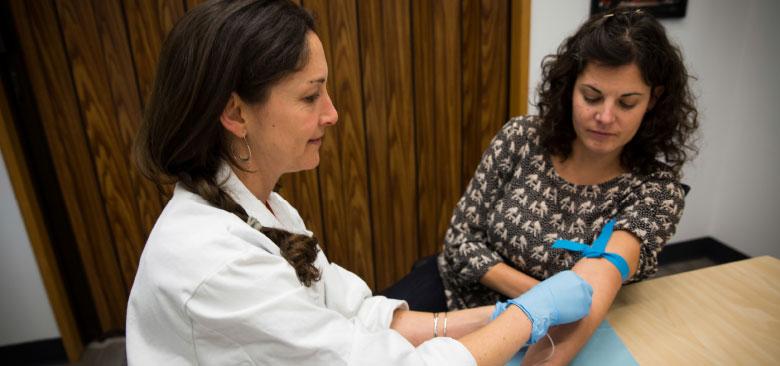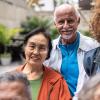
Genomics researcher Elena Flowers has her blood drawn as part of her hands-on approach to understanding the implications of genomics profiling. (Photos by Elisabeth Fall)
A Personal Genomics Journey
While on vacation in Chicago, I was walking down the street with my mom and sister-in-law and skimming my work emails when I saw one informing me that my Chancellor’s Faculty Development Fund application to have my genome sequenced had been approved. It stopped me in my tracks.
My reaction was complicated. For one, I didn’t expect it; I had assumed that since I’d been funded last year, this year would be someone else’s turn. I also wasn’t entirely sure what I was getting into. I am a genomics researcher charged with teaching the topic to advanced practice nursing students; and early in 2016, on a whim, I mentioned to my lab colleagues that I thought having my genome sequenced might make an interesting project for the Development Fund, and they loved the idea. With less than 24 hours to consider what this might mean for me and my family, the next day I submitted an application. Now I worried that some might consider the project a selfish endeavor – and, more important, I worried about what it would mean to actually have my genome sequenced.
My mom, who had already done some genetic testing through 23andMe, asked, “What is it?” I explained I would be doing something similar to 23andMe, except that her results were like excerpts from a text, whereas I would be receiving every single letter of every word – and all the punctuation – in a language I don’t speak. I knew all too well that I was opening a Pandora’s box, with lasting implications, both personal and professional. Suddenly, while walking down that street with my mother and sister-in-law, I understood that a whim had become reality.
Complex Questions
One of the most astonishing implications of advances in genomic sequencing is that soon – very soon – such information will be widely available. In 2001, when a working draft of the Human Genome Project was completed, the process of sequencing that first genome was incredibly expensive. Since then, technology advances have ratcheted down the costs at an unprecedented rate, so that today, we have just about reached the $1,000 genome. That’s considerably less than many standard diagnostic tests.
 Photo courtesy of National Human Genome Research Institute (genome.gov) Thus it’s probably not surprising that there have been numerous reports, in both popular media and scientific publications, about individuals sequencing their genomes. Many of these reports balance the exciting possibilities of personalized medicine with important concerns about the societal, clinical and personal impacts of making genomic profiles widely accessible.
Photo courtesy of National Human Genome Research Institute (genome.gov) Thus it’s probably not surprising that there have been numerous reports, in both popular media and scientific publications, about individuals sequencing their genomes. Many of these reports balance the exciting possibilities of personalized medicine with important concerns about the societal, clinical and personal impacts of making genomic profiles widely accessible.
For me, at least, a few questions come immediately to mind.
Just because it’s possible, is it sensible or ethical for individuals to have their entire genome sequenced? Even if the answer is yes, when is the proper time to do so? Should we sequence newborns, so we can learn early in their life about conditions that won’t emerge until late adulthood? How do we handle consent in such cases?
More broadly, where should this deeply personal data be stored? How should we analyze the data and provide results? How should individuals and their clinicians respond to results? Who will be qualified to counsel people about these data? Do such people/qualifications even exist at this point? How do we begin to train people when we don’t even understand the complex interactions among genes, or between genes and the environment?
The Impact on Nursing
These questions can start to make me queasy if I think about them too hard. As I noted earlier, one of my roles at UC San Francisco School of Nursing is to teach genomics content to students in our master’s program who are training to become advanced practice nurses. That matters because nurses are likely to be among those most affected, as they are in a key frontline position, poised to help individuals navigate, at the very least, today’s known challenges.
Yet it’s quite clear to me that we don’t have a handle on how we should educate and re-educate a nursing workforce so it can adapt to the genomics revolution. Who even knows what we need to know? As a starting point, the list of genetic/genomic competencies is so lengthy that contemplating it will make you laugh and also make you want to roll your eyes and say, “Why bother even starting?” I also know – and am very concerned – that our students are going to have patients bringing in their 23andMe results, asking for interpretation. That’s just a little sidebar during a 15-minute clinic visit in which the provider must, among other things, address multiple health concerns, manage polypharmacy and counsel the patient about health promotion. The truth is that few providers, much less their patients, truly understand the kinds of results they may receive from the rapidly growing menu of aggressively marketed direct-to-consumer tests.
I would argue, therefore, that nurses, as we always have, should approach patients with a holistic perspective. That’s who we are and what we should own – Florence’s great contribution to health care. Since we now have the capability to know nearly everything about the base layer of an individual’s biology, we have to set ourselves the task of understanding what to do with that information in the context of an individual’s entire life circumstances. How do childhood, family, job (or lack of one), diet, racial identity, sexual identity – the list of environmental, cultural and psychological factors is nearly infinite – interact with a person’s biological truth? It’s time to dig in and start to truly explore what we should do to help manage the health of the whole person with the massive new layer of information that the human genome represents. No one knows the path forward, but we have an ethical mandate to figure it out. It won’t be easy – we’ll have to course correct a lot along the way – but it’s time to get to work.
These are some of the thoughts that have been keeping me up at night – an outgrowth of the thoughts that pushed me toward having my own genome sequenced. I figured, start with experiential learning. See what it’s like, and then share my story with my students, hoping that it will have cascading benefits. In the next few months, through a series of posts and videos, please join me on this journey to see what it means to sequence my genome.
 Elena Flowers is an assistant professor in the UCSF School of Nursing. Her program of research is focused on identification of novel molecular markers associated with cardiovascular disease (CVD) risk factors and responses to risk reduction interventions among racial minority groups. She published numerous papers describing CVD risk in South Asians, which led to current studies evaluating microRNAs as prodromal predictors of progression to CVD and type 2 diabetes. Presently, she is investigating microRNAs as predictors of responses to behavioral interventions to reduce risk (e.g., weight loss, physical activity, yoga). Her research has expanded to include high-risk Filipino and Latino populations. She is director of the School’s genomics laboratory and Genomics Minor. She is also active in the American Heart Association, the American Diabetes Association, the Preventive Cardiovascular Nurses Association and the International Society of Nurses in Genetics.
Elena Flowers is an assistant professor in the UCSF School of Nursing. Her program of research is focused on identification of novel molecular markers associated with cardiovascular disease (CVD) risk factors and responses to risk reduction interventions among racial minority groups. She published numerous papers describing CVD risk in South Asians, which led to current studies evaluating microRNAs as prodromal predictors of progression to CVD and type 2 diabetes. Presently, she is investigating microRNAs as predictors of responses to behavioral interventions to reduce risk (e.g., weight loss, physical activity, yoga). Her research has expanded to include high-risk Filipino and Latino populations. She is director of the School’s genomics laboratory and Genomics Minor. She is also active in the American Heart Association, the American Diabetes Association, the Preventive Cardiovascular Nurses Association and the International Society of Nurses in Genetics.



